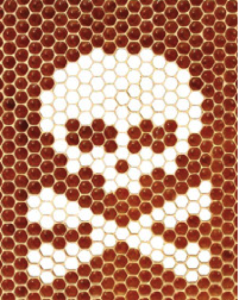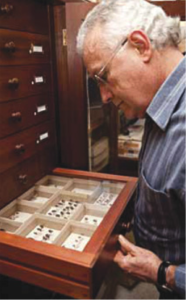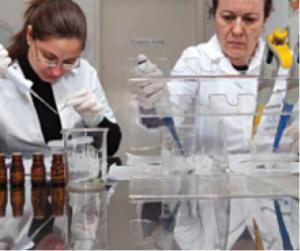
The disappearance of bees
Martha San Juan França – mfranca@reitoria.unesp.br
Matter originally published in UNESP magazine – September 2012
Made at UNESP studies are among those who led the IBAMA to suspend the use of a type of insecticide in the country's crops. The product appears to be decimating the populations of this insect pollinator, which is key to food security
Surrounded by orange groves and sugar cane fields, beekeeper Sergio Trevisan faces for at least five years an uphill struggle. In 2007, It was the first round. “Was dead bee everywhere”, tells the story of UNESP Science. A causa, he and the other beekeepers in the small Tabatinga, city of Araraquara region, in São Paulo, Very knowledgeable: aerial spraying crops with pesticides known as neonicotinoids.
“To understand that staff have need to use insecticide, but they need to know that the product sprayed by plane or tractor kills all that is insect, not only the pests”, the firm.
Considered what is most modern in the field of insect control in agriculture, the neonicotinoids attack the nervous system of these animals. But the product ends up spreading through the air and depositing flowers, where the bees collect nectar. “Of them die in the hive door, the rest did not realize or to get there”, account Trevisan.
The beekeeper sought health and environmental agencies Tabatinga, but could not prove the reason for the tragedy that compromises their livelihood.
Last August, Trevisan was behind the biologist Osmar Malaspina, UNESP of the Social Insects Studies Center in Rio Claro, studying the action of these insecticides in the brains of bees. Between 2008 is 2010, Malaspina searched loss 10 thousand hives of Apis mellifera (Africanized bees, with stinger), killed by insecticides in Rio Claro region. Their results showed that in about a thousand had traces of neonicotinoids.
According to researcher, cases such as Tabatinga repeat themselves in nearby cities like Brotas, Hawk Peixoto, Boa Esperança do Sul and Iacanga, where for almost ten years farmers fighting the “greening”, orange disease whose vector is a small insect-controlled aerial spraying or made directly in the plant. Another problem was the prohibition of burning in sugarcane plantations. The fire, that away before any kind of plague, It was replaced by pesticides.
“I am not against the use of insecticides, but we must establish a proper policy for that cause no damage”, says researcher. In the face of evidence that accumulate in the interior and in other states, he was called to assist IBAMA. In July this year, the agency has temporarily suspended the applications of neonicotinoids and began to re-evaluate its use on crops across the country. Three representatives of this class of insecticides are under suspicion: imidacloprido, tiametoxam e clotianidina (there is still room: o fipronil, belonging to another class, a dos fenilpirazois). The first to go through re-evaluation will be the imidacloprid, the most commercialized
The objective of this update is to define the measures that need to be taken to reduce the risks. “Manufacturers must submit additional information in order to review that suspension”, says Marisa Zerbetto, environmental control coordinator of dangerous substances and products IBAMA. “We must consider that aerial application, even when well made, It requires a lot of technique, especially within the limits of the treated area, not occur dispersal in native forest.”
The decision follows public policy guidelines of the Ministry of Environment focused on pollinators protection which includes bees, birds, butterflies, beetles and bats that assist in plant reproduction. It is also a warning for agriculture. According to the United Nations Food and Agriculture (FAO), Bees are responsible for at least 70% the pollination of crops that serve for human consumption. Its disappearance would lead to losses of more than 200 billion dollars a year.
According Ulysses Antuniassi, researcher at the Faculty of Agricultural Sciences of UNESP in Botucatu, However, the measure of IBAMA was unilateral and poorly received by farmers. Antuniassi recently proposed a classification scale pesticide application techniques to avoid “derived product”, so, its release into the environment, with water contamination, do solo e do ar. “From a biological point of view, there is a problem that must be faced in this case”, explains. “But rather to prohibit a particular active ingredient is required a study of the impact on the productive system.”
IBAMA's decision was based on international initiatives and studies conducted in Brazil, including the Rio Claro UNESP. “Most products applied for soybean, corn, Cane or orange is highly toxic to bees”, afirma Malaspina. “The problem is not only the active ingredient, but the way of handling and application.” According to him, sometimes the insecticide is released only for direct use in plant, but farmers use aircraft. Or is applied to four or five times higher doses than indicated and inappropriate times of the year.
You disoriented
Other problems may be associated. If contamination is by aerial spraying, usually bees die immediately. In smaller doses, they do not immediately succumb, but have trouble spatial orientation. Besides, They may become more vulnerable to viruses which devastate hives. Honey can also end up contaminated.
In March this year, two articles published in the journal Science by British and French researchers have shown how the action of insecticides affect the orientation capacity of bees. In the UK study, by the University of Stirling, Scotland, They were added small doses of imidacloprid Feeding 50 bee colonies. These amounts simulated those insects found in rapeseed crops that country. The other 25 colonies were given a diet free of pesticide.
The bees were left at liberty for six weeks so they could look for their food on plantations. At the end of that period, colonies that had been exposed to the insecticide were 8% a 12% lighter than those free from the substance. The difference in weight is due to, on the one hand, the fact that the insects have brought less food to the hive and, for another, a fall in the number of workers births.
The most obvious result of the study was the difference in the number of queens. In insecticide-free hives were found on average 13 for each of queens, while the receiving contaminated feed that number dropped to 1,7. Although the study did not clarify the cause of this phenomenon, the authors suggest that it is in pesticides, They are affecting the nervous system of bees and distorted orientate capacity.
This interpretation coincides with the data of the French study with thiamethoxam. Researchers at the National Agricultural Research Institute (Inra), Avignon, fixed electronic chips to the chest 653 bees, part of which received one dose of insecticide. They observed that 43% insects exposed to the substance died outside the hive, presumably because they have lost. Among those who did not receive the insecticide, 17% They died outside the hive.
In a statement, Michael Henry, first author of the French study, said the results “They have important implications when it comes to pesticides authorization procedures”. According to researcher, so far, The authorization of such products required only that manufacturers demonstrate that the active ingredient does not directly cause the death of bees in doses commonly employed. But to ignore the consequences of doses that do not kill, but can change the behavior of bees.
The Malaspina team in Rio Claro, in association with researchers from Kenya and the Netherlands, It is conducting studies to determine the effect of sublethal doses of neonicotinoids and other pesticides on bees, mainly of native species or meliponídeas, known as stingless bees, that are less studied. Coordinated by FAO, the three groups also plan to standardize assessment methodologies, both the native bee, as of Apis mellifera for the results of the studies can be compared.
“Native bees, as jataí, irapuá, uruçu, suffer greatly from the destruction of the environment, no local options for nesting”, says postdoctoral Andrigo Pereira, specialist behavior of these insects and project participant. He cites the importance of these species for the protection of plant, giving as an example the bumblebee. Despite producing little honey, it is instrumental in pollination over 60 species plants, including passion fruit, and had the number of individuals decreased significantly in southern Brazil.
Action in the brain
According to biologist Robert Nocelli, the Federal University of São Carlos (UFS-Car), Of course associated with the Rio Group, the Ministry of Agriculture considers the toxicity of pesticides to honey bees, but no studies to other species. “We believe that meliponídeas find it more difficult to degrade these products and therefore are more sensitive”, the firm.
To test this hypothesis, UNESP researchers are conducting morphological and behavioral studies in laboratory, with different doses of products that act on the nervous system of bees, including the neonicotinoids.
In the brain, this insecticide class has action similar to nicotine. Both stimulate a brain receptor is normally activated by the neurotransmitter acetylcholine, both in humans and insects. It turns out that, Unlike nicotine acetylcholine and, the neonicotinoids bind to this receptor (called cholinergic) irreversibly, causing neuronal overstimulation. As the affinity between cholinergic receptors and the neonicotinoids is much higher in insects than in humans, the product is more toxic to the former than to the latter.
The researchers' goal is to establish the lethal dose of these insecticides and from there also verify their non-lethal effects in stingless bees and honey. “We see the action on the nervous system and also in the digestive system, in this case the bees when they ingest the product”, explains postdoctoral Thaisa Roat. It analyzes the morphological damage that compromise the structure of the brain responsible for vision, smell and processing information of bees and can explain the disorientation field. The same is done at the larval stage. “Insecticide doses may accelerate or inhibit the metamorphosis of bees”, says.
The morphological data are compared with those obtained in behavioral studies, evaluating, for example, reflex of the tongue to reach food and motor activity. “We try to assess the minimum dose that begins to change the cognitive system of bees”, explains co Andrigo Pereira.
The suspicion that neonicotinoids can cause mortality in bees in short or long term is old. In 2004, of these substances has been banned in France, Germany and Italy. We US, However, a petition calling for the suspension of these products, signed by 25 environmental organizations and beekeepers, It was rejected this year by the Environmental Protection Agency (EPA, in English), on the grounds that more data are needed on the subject.
This does not mean that Americans are not concerned about the disappearance of bees, quite the opposite. There was coined, in 2007, CCD expression, which in Portuguese means “collapse disorder colonies”, to refer to the sudden disappearance and no apparent cause of a large number of these insects. Some possible explanations have been identified, as the virus emergence, problems of genetic variability, lack of adequate food, intensity in the management of hives and intensive use of pesticides. But nothing was proved.
In Brazil, the problem was also diagnosed in several states, main-mind in the South. The data are not conclusive and therefore researchers as Malaspina prefer not to use the term CCD to refer to the disappearance of these insects. The greatest difficulty is to prove the cause of death, since beekeepers do not know how to forward the samples to laboratories. Malaspina suggests that we make a photographic documentation of the hives and beekeepers register police report if they want to go to court, when they believe that the cause may be the application of insecticide.
To better understand the phenomenon and the importance of pollinating insects for agriculture in Brazil, researchers 36 scientific institutions, including the Rio Claro UNESP group, supported by CNPq and the Agribusiness Sector Fund, just released the book Pollinators in Brazil – contribution and prospects for biodiversity, sustainable use, conservation and environmental services. The book is the first document in Portuguese that addresses the knowledge of pollinators in both natural areas as agro-ecosystems.
According to researchers, the loss of insects worsens in the country with the clearing of forests and burning, affecting the development of the colonies of native bees, many of them still unknown and not adapted to the management. The extinction of these bees can cause an ecological problem of large proportions, since they are responsible for pollination of the plants of different native biomas.





Sorry, the comment form is closed at this time.